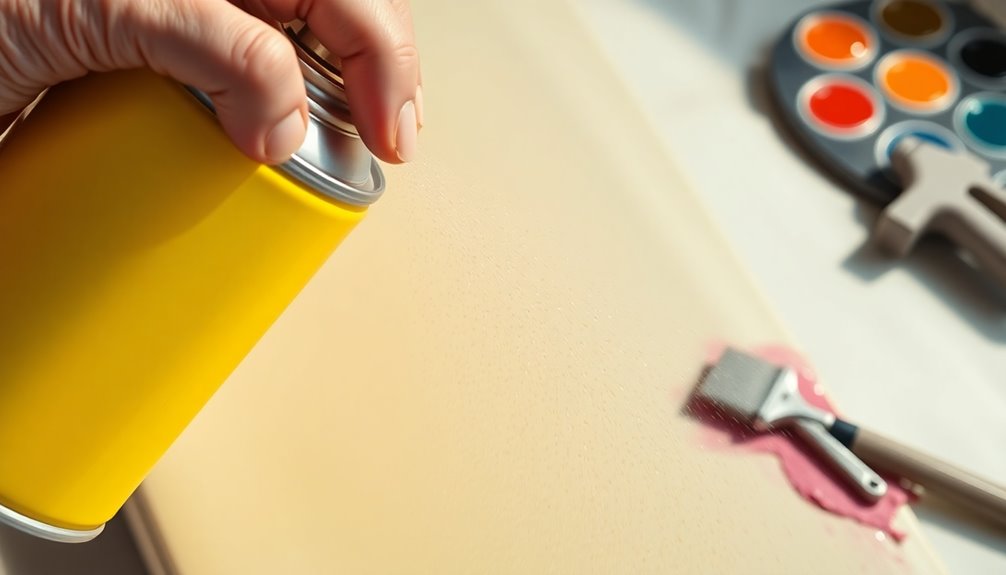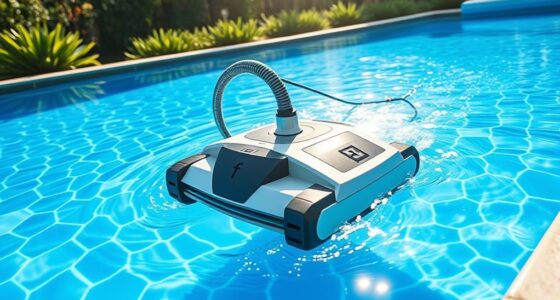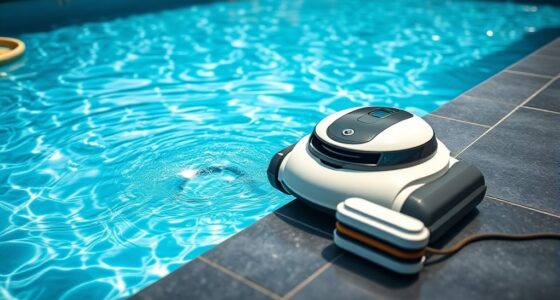To achieve a smooth and durable finish on plastic, start with thorough surface preparation. Clean the plastic with mild detergent, inspect for scratches, and lightly sand it for better paint adherence. Choose water-based acrylics or acrylic-enamel paints designed for plastics. When applying, use a plastic-specific primer, followed by thin layers of paint while allowing each coat to dry completely. Consider adding a clear coat for extra protection and shine. Finally, maintain a dust-free environment during drying to ensure quality. There's plenty more to discover about optimizing your plastic painting process, so keep exploring for even better results!
Key Takeaways
- Thoroughly clean and prep the plastic surface by sanding, removing old paint, and ensuring it is dry before painting.
- Choose water-based acrylics or enamels for their durability and compatibility with plastic surfaces.
- Apply a plastic-specific primer and paint in thin, even coats, allowing each layer to dry completely before the next.
- Allow adequate curing time in a dust-free environment to ensure strong adhesion and a smooth finish.
- Maintain painted surfaces with gentle cleaning and regular application of protectants to preserve appearance and longevity.
Importance of Surface Preparation
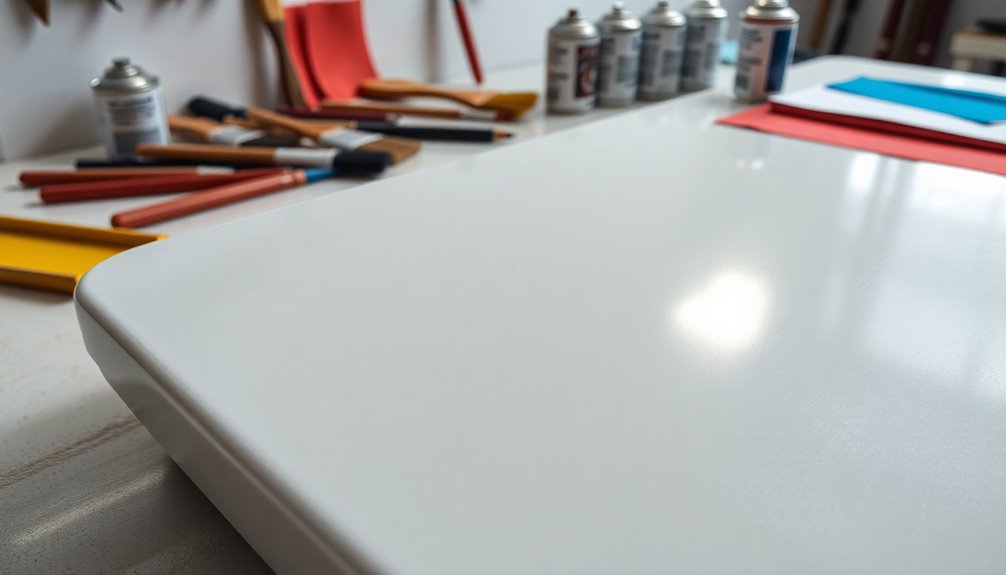
When you want to achieve a professional-looking finish on plastic, surface preparation is crucial. Start by cleaning the surface with a mild detergent and water to remove dirt and grime. Wipe it down with a cloth to eliminate any soap residue, and make sure it's completely dry.
Next, inspect for imperfections like scratches. For a smoother finish, sand the surface using fine-grit sandpaper, gradually increasing the grit. Always sand in one direction to avoid scratches, and remove any dust with a vacuum or compressed air.
If there's old paint or adhesives, use a paint stripper, scrape it off, and clean the area again. Taking these steps ensures your paint adheres well for a durable finish.
Choosing the Right Paint
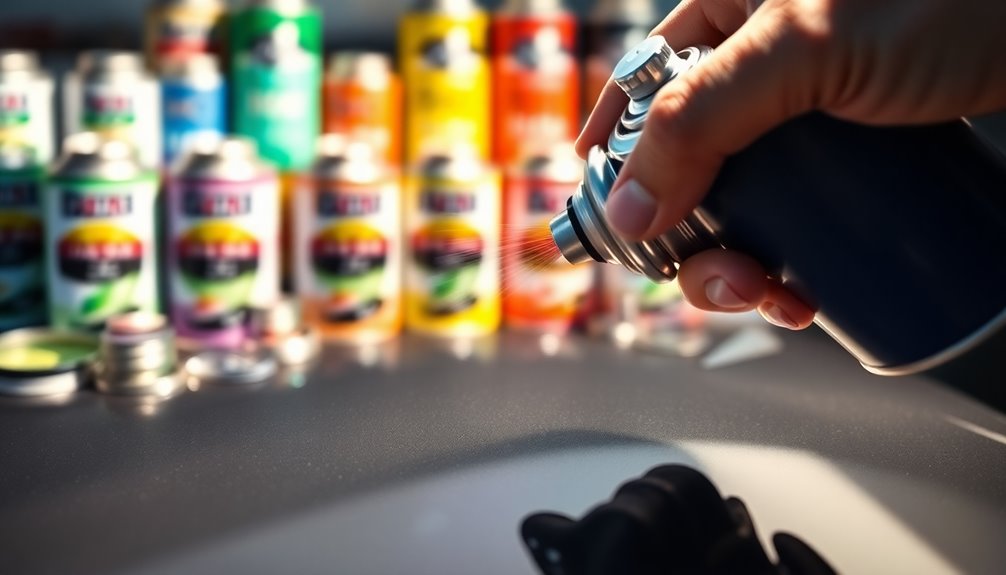
Selecting the right paint is essential for achieving a flawless finish on plastic surfaces.
For smooth application, consider water-based acrylics like FolkArt Multi-Surface or DecoArt Americana, both known for their creamy consistency and easy use. Proper paint selection is crucial because painting plastic poses unique challenges due to its non-porous nature.
If you're aiming for a glossier finish, water-based enamels are excellent for plastic, as they adhere well and resist washing.
For a blend of benefits, acrylic-enamel-based paints provide durability and a wide color selection.
Specialty options like Krylon Fusion and Zinsser Allcoat Exterior offer versatility and long-lasting results.
Effective Application Techniques
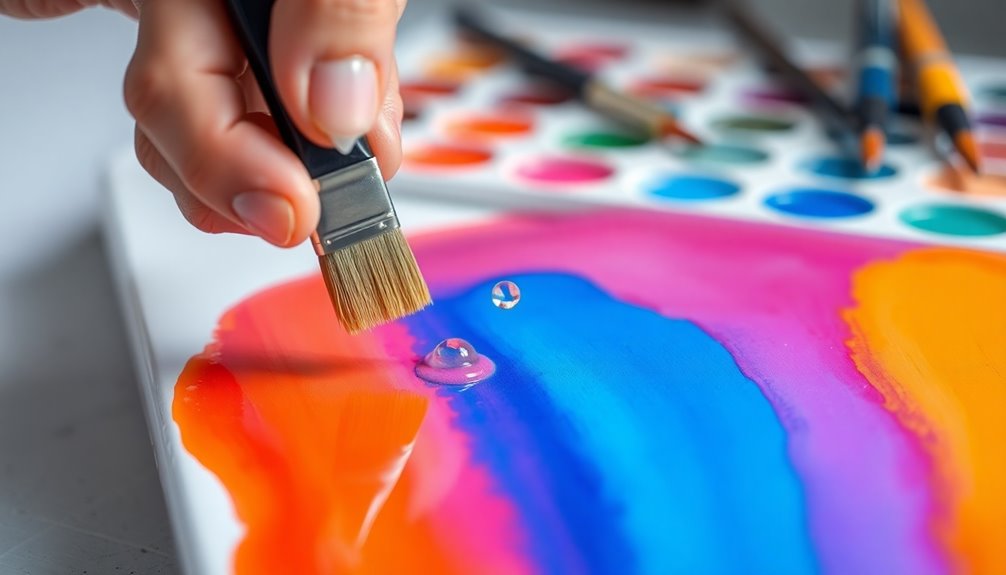
To achieve a smooth and professional finish on plastic surfaces, mastering effective application techniques is crucial. Start by roughening the surface with fine-grit sandpaper for better adhesion. Clean it thoroughly using a dry cloth followed by a wet rag with mineral spirits or isopropyl alcohol. Apply a plastic-specific primer in thin, even coats using a zig-zag pattern, ensuring it dries completely before painting. Additionally, sanding is essential for optimal paint adhesion on plastic surfaces.
Maintain a distance of at least 10 inches while spraying paint, applying multiple light coats to prevent drips. You can spin the item on a lazy Susan for an even coat. Lastly, avoid overlapping your spray to maintain a consistent finish. Following these steps will help you achieve a durable, attractive paint job on plastic.
Understanding Drying and Curing
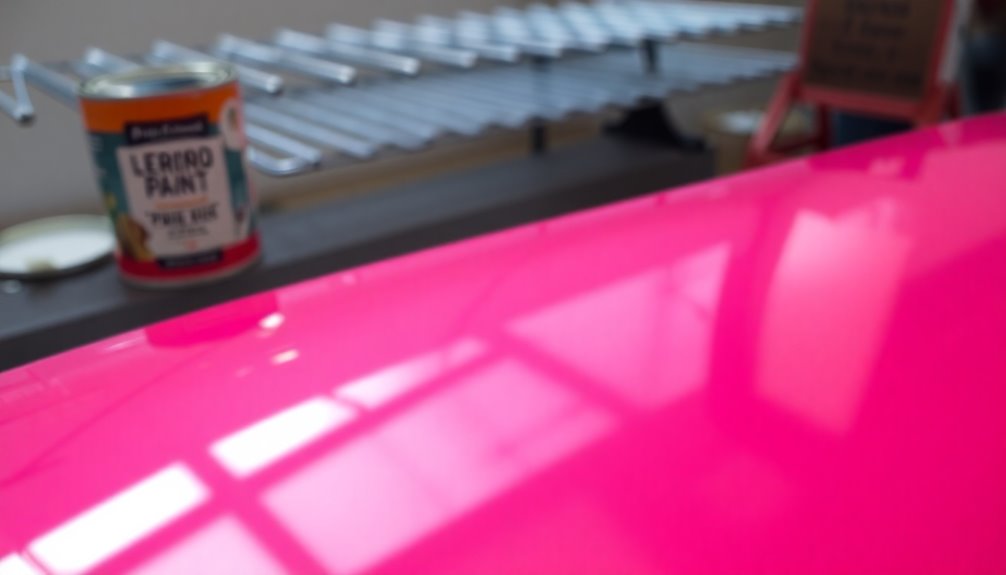
Achieving a perfect paint job on plastic doesn't stop with effective application techniques; understanding the drying and curing process is just as important. Several factors affect drying time, including temperature, humidity, and air circulation. Warmer, drier environments promote quicker drying, while proper surface preparation enhances adhesion and speeds up the process.
The drying process involves stages, starting with evaporation and ending with final drying, where the paint may still be curing. Curing is crucial for hardening the paint, ensuring strong adhesion, and enhancing durability.
To speed up curing, you can use UV light, apply heat, or improve air circulation. Controlling your environment can also make a significant difference, ultimately leading to a high-quality finish.
Applying Additional Coats
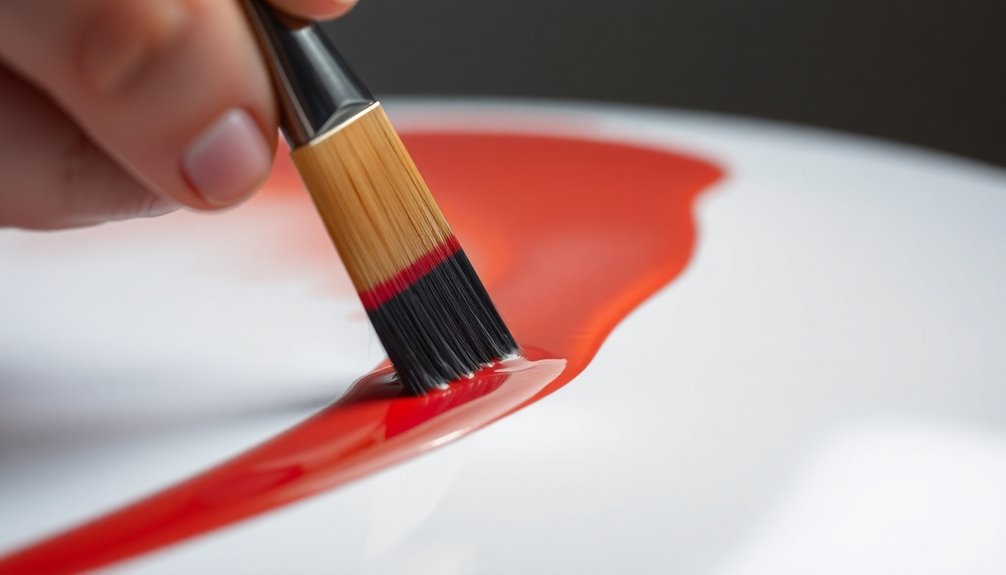
Applying additional coats of paint is crucial for achieving a vibrant and durable finish on plastic surfaces.
Start by applying thin layers, letting each coat dry completely before adding the next. This prevents drips and uneven finishes. Use a brush for detailed areas and a roller for larger surfaces.
It's essential to work in a well-ventilated area to avoid inhaling fumes. Always follow the manufacturer's drying times to ensure optimal adhesion.
If necessary, lightly sand between coats to enhance smoothness, and inspect for imperfections after each layer.
Safety Precautions to Follow
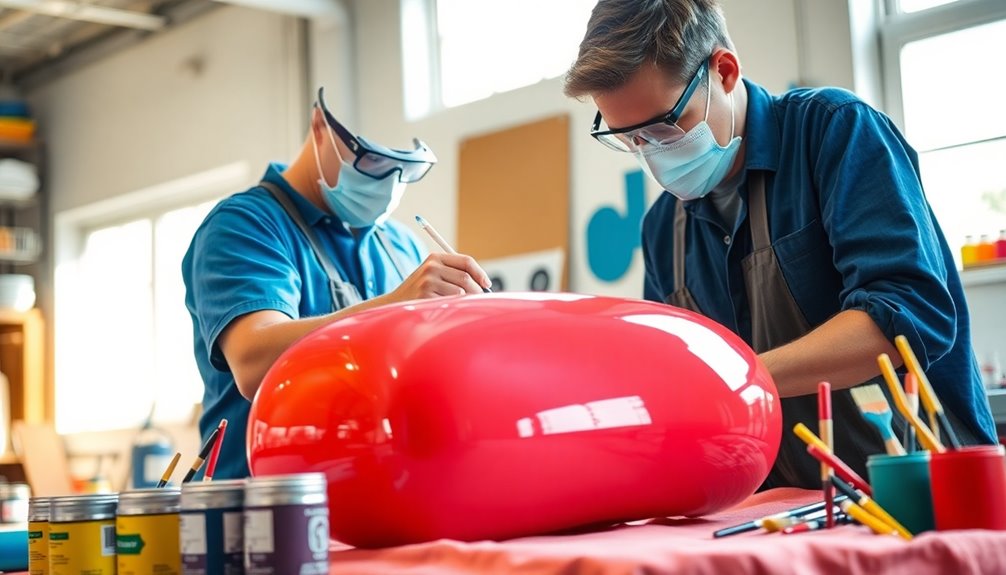
After applying additional coats, it's important to prioritize safety during the painting process.
Start by ensuring your workspace is well-ventilated to avoid inhaling fumes. Cover surfaces with drop cloths to protect them from paint splashes. Don safety goggles to shield your eyes and wear gloves to prevent skin irritation. Don't forget to remove any jewelry to keep it paint-free.
Choose a paint specifically designed for plastics, and carefully read the instructions to confirm compatibility. Open paint cans in a ventilated area and use a stir stick for mixing.
Clean tools right after use and dispose of any leftover paint properly. Finally, wash your hands thoroughly and monitor for fumes before touching your newly painted surface.
Ensuring Long-Term Durability
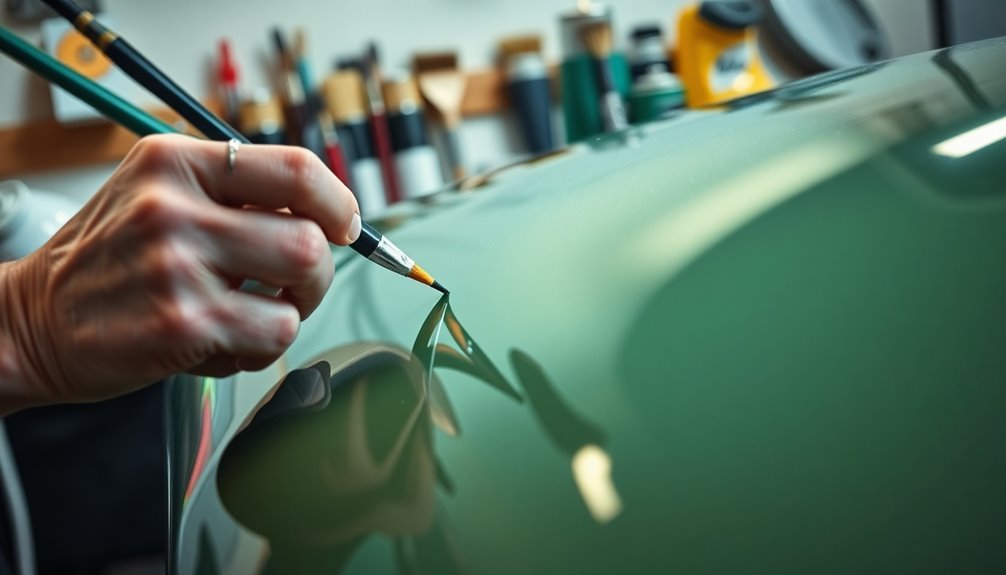
To ensure your painted plastic surfaces stand the test of time, proper preparation and material selection are crucial.
Start by cleaning the surface with a mild detergent to remove dirt and grease, then dry it completely. Sand any rough spots and scrape off old paint if necessary.
Choose a high-quality, outdoor-grade plastic paint that's specifically designed for plastic and offers UV resistance. Applying a primer can improve adhesion, so consider that for glossy or porous surfaces.
Use thin, even coats, allowing each to dry fully. Finally, enhance durability by applying a clear topcoat and inspecting your work regularly for wear.
Prompt touch-ups can prevent further damage and maintain the finish's integrity.
Maintenance Tips for Painted Plastic
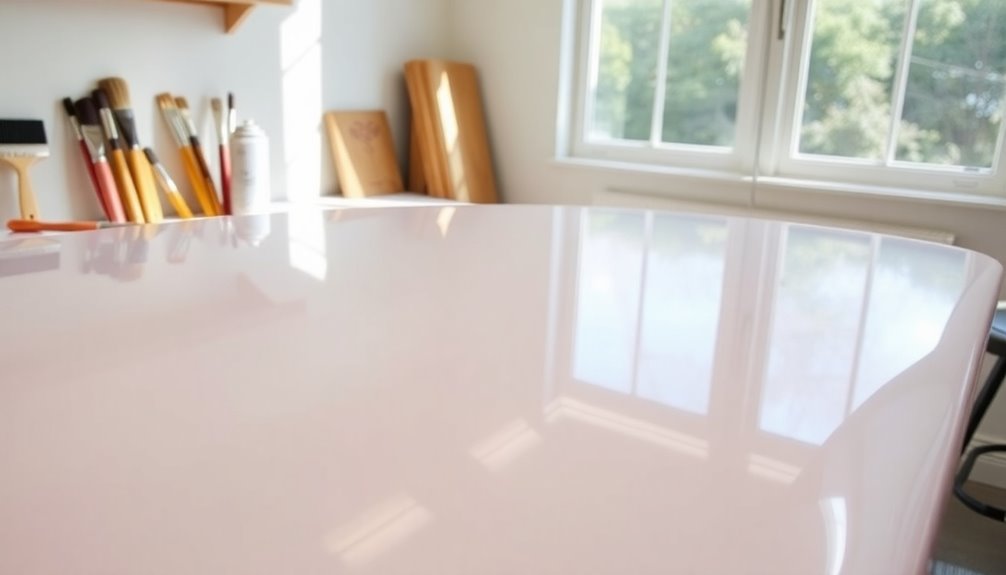
Maintaining painted plastic surfaces is essential for keeping them looking fresh and vibrant.
Start by cleaning the surface thoroughly using an all-purpose cleaner or soap and water. Avoid abrasive cleaners that could scratch the plastic.
If needed, fix any damage with high-strength plastic glue or a soldering iron, taking care of potential discoloration. Regularly checking and cleaning your air purifier's filters and maintenance can help ensure optimal performance in your environment.
To remove overspray or stains, use appropriate solvents like mineral spirits or isopropyl alcohol, and always dry the surface afterward to prevent water spots. Additionally, proper preparation steps such as cleaning and sanding can enhance the longevity of your painted surfaces.
For long-lasting protection, apply a plastic trim protectant, massaging it in with a clean applicator.
Regularly clean and restore your painted plastic using an all-purpose cleaner and a plastic trim dye to maintain its appearance and durability.
Common Mistakes to Avoid
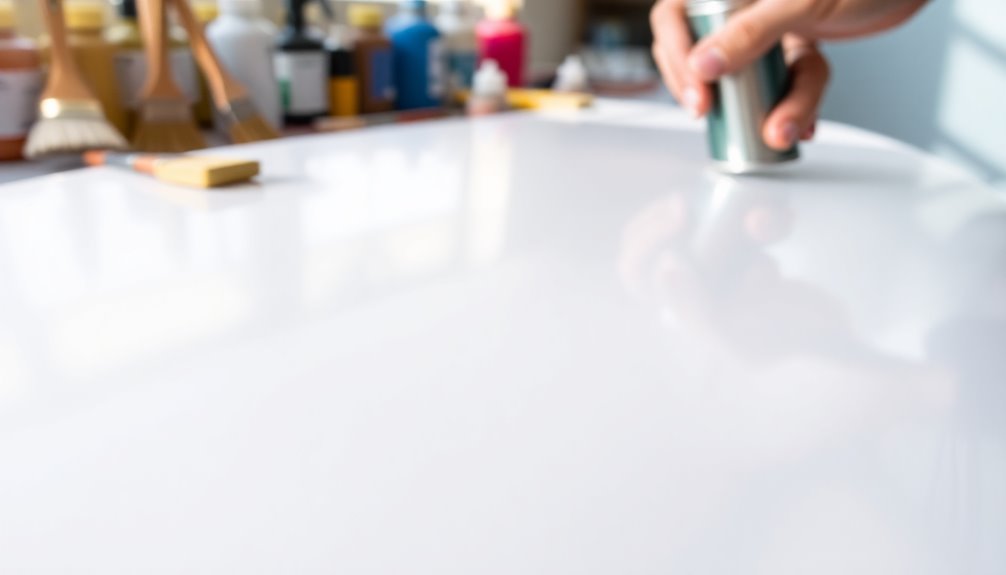
When painting plastic, avoiding common mistakes can make all the difference between a professional-looking finish and a disappointing result.
First, choose the right tools; using the wrong roller nap or cheap brushes can lead to streaks and uneven coverage. Selecting the correct roller cover nap is crucial for achieving a smooth application.
Don't skip cleaning the surface—removing grime and mildew is crucial for adhesion.
Always use primer and test paint on the surface to prevent issues later.
Apply paint carefully, avoiding too much at once and maintaining a wet edge for seamless results.
Lastly, don't rush the process. Allow each coat to dry fully and work in good lighting for accurate lines.
Enhancing Appearance With Finishing Touches
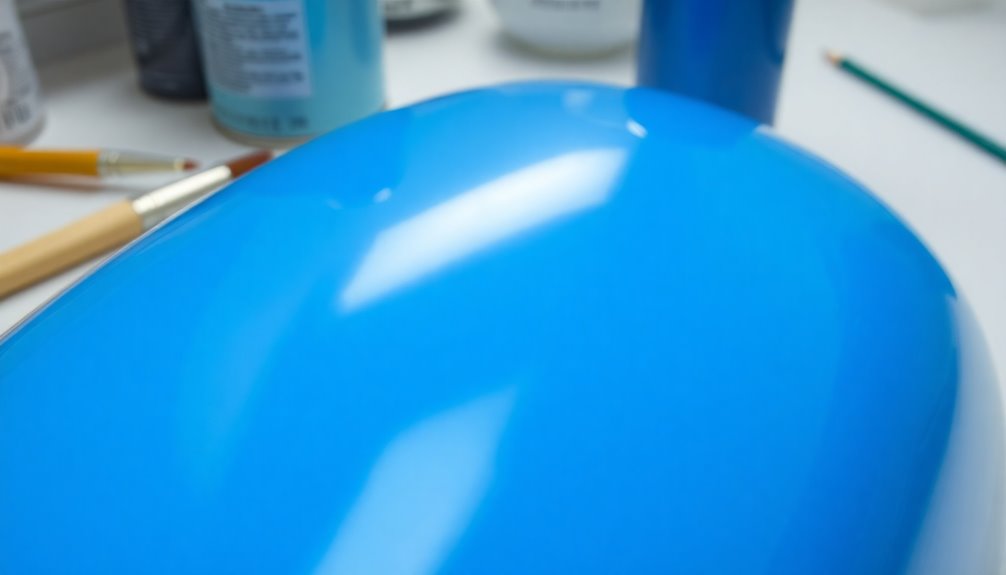
Achieving a professional finish on plastic doesn't stop with avoiding common mistakes; enhancing the appearance with finishing touches can elevate your project to the next level.
Start by properly preparing the surface—clean it thoroughly, lightly sand it, and ensure it's dry before you paint. Apply a compatible primer for better adhesion, letting it dry completely.
When painting, use thin layers and allow each coat to dry before adding another. Once the paint is on, consider applying a clear coat for added shine and protection against UV rays and scratches. This additional layer provides a durable barrier to further enhance the longevity of your finish.
For a showroom-quality finish, sand and buff the painted surface, removing any imperfections.
Finally, conduct a thorough inspection and ensure you allow adequate drying time before using the item.
Frequently Asked Questions
Can I Paint Plastic Without Sanding?
Yes, you can paint plastic without sanding, but preparation's crucial.
Start by cleaning the surface thoroughly to remove dirt and grease. Use a suitable primer designed for plastic to improve adhesion. After applying the primer, choose a high-quality paint that is specifically formulated for plastic surfaces to ensure a durable finish. If the surface has stubborn residues, consider using the best degreasers for tough grease to achieve a clean slate. Allow everything to dry completely before applying additional coats of paint for the best results.
Choose a paint specifically made for plastics, like acrylic or spray paint, for the best results. Apply thin coats and let each layer dry completely.
This way, you can achieve a smooth finish without the hassle of sanding.
How Can I Remove Paint From Plastic?
To remove paint from plastic, you've got a few effective methods.
You can use chemical strippers like acetone or mechanical tools such as scrapers and heat guns.
If you prefer a less aggressive approach, try enzyme-based strippers that break down the paint.
Whichever method you choose, make sure to wear protective gear and clean the surface thoroughly afterward.
With patience, you'll restore your plastic item to its original condition.
Is It Safe to Paint Plastic Indoors?
Yes, it's generally safe to paint plastic indoors if you take proper precautions.
Ensure good ventilation by opening windows and using fans to disperse fumes. Opt for low VOC spray paints to minimize harmful emissions.
Always wear a mask, goggles, and gloves for protection. Clean the surface thoroughly before painting, and cover any nearby furniture or floors to prevent spills.
Following these steps will help you paint safely and effectively indoors.
What Tools Do I Need for Painting Plastic?
When you're painting plastic, you'll need several essential tools to get the job done right.
Start with sandpaper for surface prep, a cleaning solution, and rags to wipe down surfaces.
Masking tape and drop cloths protect surrounding areas.
For painting, grab brushes, a roller, and a paint tray.
Don't forget safety gear like gloves, goggles, and a mask to keep yourself safe.
With these tools, you're ready to tackle your project!
How Long Will Painted Plastic Last Outdoors?
"An ounce of prevention is worth a pound of cure."
When you paint plastic for outdoor use, its longevity largely depends on factors like paint quality, environmental conditions, and maintenance.
With proper preparation and the right products, you can expect your painted plastic to last several years.
However, be mindful of harsh weather and UV exposure, as these can wear down the finish over time, necessitating touch-ups or complete repainting.
Conclusion
In painting plastic, think of your project as a blank canvas waiting to bloom. By preparing the surface and choosing the right paint, you're planting the seeds for a vibrant finish. With careful application and patience, you'll nurture that paint to a lasting beauty. Just as a garden thrives with care, your painted plastic can shine with color and durability. So, embrace the process, tend to your creation, and watch it flourish in your space!
